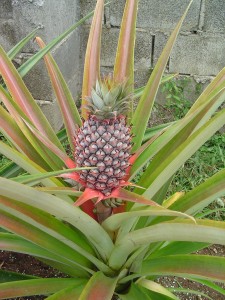
Pineapple plant. photo: CameliaTWU, flickr (click photo to see in original context)
Pineapples use CAM photosynthesis. Normally plants have to open tiny holes in their leaves (called stomata) during the day to let in carbon dioxide that they use during photosynthesis. The problem they face is that when they’re letting carbon-dioxide in, plants also let water out.
CAM plants get around this water loss by collecting all their carbon dioxide at night (when it’s not as hot so they lose less water when they open their stomata) and storing it within their leaves until they need it during the day. This allows them to be much more efficient with water than normal plants (ones carry out plain old vanilla C3 photosynthesis.*)
Why do pineapple plants need to be so frugal when it comes to water? The fact that pineapples are native to paraguay and southern brazil is repeated across the internet, but as you can imagine, that description covers a wide range of climates and habitats some of which are much drier than others. Clearly more research on the subject is called for on my part.
The fact that pineapples do CAM photosynthesis came up in a discussion with another guy in my lab where we discussed the fact that pineapples would make an excellent comparison for grass genomes** and have a reasonably small genome at ~500 megabases***, half the size of the recently published soybean and sorghum genomes and less than a quarter the size of the maize genome.
With all these new third generation sequencing technologies coming out in 2010, hopefully someone will sequence the pineapple genome. If not, maybe the cost of sequencing will drop enough while I’m in grad school that I can sequence the genome myself ( a guy can dream).
For more on my long running admiration for pineapple (second only to my appreciation of corn itself):
Why Pineapples are Awesome.
Phylogeny of Pineapple, an further explanation of awesomeness.
*Let the record reflect that corn does C4 photosynthesis, which another awesome variation on the standard system of photosynthesis.
**In addition to both pineapple and grasses being monocots, they’re in the same order of plants, Poales, as grasses. The first non-grass monocot to be sequenced will almost certainly be the banana (in fact the process as already begun), but while bananas are monocots they belong to a different order Zingiberales (which includes spice plants like ginger, cardamom, and tumeric).
***526 Megabases as cited in Patterson AH, Freeling M, Sasaki, T “Grains of Knowledge” Genome Research 10.1101/gr.3725905

